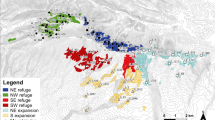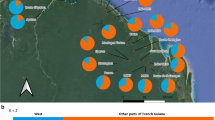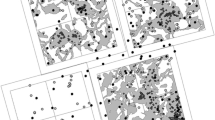Abstract
Deforestation and abandonment of neotropical agricultural land has led to rapid exploitation by pioneer species. As recolonised populations may be founded by a limited number of individuals, there is significant potential for genetic bottlenecks. Previous studies of pioneer tree dynamics have failed to consider population density interactions (by sampling populations with different densities) and the multigenerational consequences of recolonisation. In this paper we examine the genetic outcomes of a clearance/recolonisation regime for a Costa Rican long-lived pioneer species, Vochysia ferruginea, at a series of sites with different densities and across multi-generational cohorts (old growth forest, secondary forest and seedlings) using variation for amplified fragment length polymorphism (AFLPs) and single sequence repeats (SSRs, microsatellites). A clearance/recolonisation phase was found to significantly increase fine-scale genetic structuring (average intensity of spatial genetic structure, Sp [SSR] = 0.0358) compared to old growth forest (Sp = 0.0126), and significantly reduces genetic diversity (Shannon’s index [AFLP] = 0.202 and 0.271–0.355 for other forest histories following density correction), which compounds over generations (e.g. at Tirimbina: old growth forest, allelic richness, RT [SSR] = 8.86; secondary forest RT = 7.95; seedlings RT = 4.76). Spatial structuring of closely related individuals suggests that V. ferruginea colonises sites via early invaders, which establish patches with half sib relationship. The variability observed between cohorts for genetic differentiation and inbreeding coefficients suggests that the presence of remnant trees can have an important impact on the genetic make up of recolonised populations. One main concern from these results is that if secondary forest blocks harbour reduced genetic diversity and persist in the landscape, then species like V. ferruginea may be forced into a downward spiral of diversity loss if old growth remnants, which harbour higher diversity, are cleared and secondary blocks are used as reforestation sources.






Similar content being viewed by others
References
Aldrich PR, Hamrick JL (1998) Reproductive dominance of pasture trees in a fragmented tropical forest mosaic. Science 281:103–105
Alvarez-Buylla ER, Garay AA (1994) Population genetic structure of Cecropia obtusifolia, a tropical pioneer species. Evolution 48:437–453
Austerlitz F, Mariette S, Machon N, Gouyon PH, Godelle B (2000) Effects of colonisation processes on genetic diversity: differences between annual plants and tree species. Genetics 154:1309–1321
Bawa KS, Perry DR, Beach JH (1985) Reproductive biology of tropical lowland rain forest trees. I. Sexual systems and incompatibility mechanisms. Am J Bot 72:331–345
Boucher DH, Mallona MA (1997) Recovery of the rain forest tree Vochysia ferruginea over 5 years following Hurricane Joan in Nicaragua: a preliminary population projection matrix. For Ecol Manag 91:195–204
Boucher DH, Vandermeer JH, Mallona MA, Zamora N, Perfecto I (1994) Resistance and resilience in a directly regenerating rainforest: Nicaraguan trees of the Vochysiaceae after Hurricane Joan. For Ecol Manag 68:127–136
Cavers S, Degen B, Caron H, Hardy O, Lemes M, Gribel R, Margis R, Salgueiro F, Lowe AJ (2005a) Optimal sampling strategy for estimation of spatial genetic structure in tree populations. Heredity 95:281–289
Cavers S, Navarro C, Hopkins P, Ennos RA, Lowe AJ (2005b) Regional and population-scale influences on genetic diversity partitioning within Costa Rican populations of the pioneer tree Vochysia ferruginea Mart. Silvae Genetica 54:258–264
Cespedes M, Gutierrez MV, Holbrook NM, Rocha OJ (2003) Restoration of genetic diversity in the dry forest tree Swietenia macrophylla (Meliaceae) after pasture abandonment in Costa Rica. Mol Ecol 12:3201–3212
Collevatti RG, Grattapaglia D, Hay JD (2001) Population genetic structure of the endangered tropical tree species Caryocar brasiliense, based on variability at microsatellite loci. Mol Ecol 10:346–356
Colpaert N, Cavers S, Bandou E, Caron H, Gheysen G, Lowe AJ (2005) Sampling tissue for DNA analysis of trees: trunk cambium as an alternative to canopy leaves. Silvae Genetica 54:265–269
Davies SJ (2006) The Population Genetic Consequences of Gene Flow during Colonisation and Regeneration of Forest Trees. PhD Thesis, Heriot-Watt University, Edinburgh, UK
Degen B, Caron H, Bandou E, Maggia L, Chevallier MH, Leveau A, Kremer A (2001a) Fine-scale spatial genetic structure of eight tropical tree species as analysed by RAPDs. Heredity 87:497–507
Degen B, Petit R, Kremer A (2001b) SGS-Spatial Genetic Software: a computer program for analysis of spatial genetic and phenotypic structures of individuals and populations. J Heredity 92:447–448
Dick CW, Etchelecu G, Austerlitz F (2003a) Pollen dispersal of tropical trees (Dinizia excelsa: Fabaceae) by native insects and African honeybees in pristine and fragmented Amazoian rainforest. Mol Ecol 12:753–764
Dick CW, Abdul-Salim K, Bermingham E (2003b) Molecular Systematics reveals cryptic tertiary diversification of a widespread tropical rainforest tree. Am Nat 162:691–703
Dlugosch KM, Parker IM (2007) Founding events in species invasions: genetic variation, adaptive evolution and the role of multiple introductions. Mol Ecol 17:431–449
Dutech C, Seiter J, Petronelli P, Joly HI, Jarne P (2002) Evidence of low gene flow in a neotropical clustered tree species in two rainforest stands of French Guiana. Mol Ecol 11:725–738
Dutech C, Maggia L, Tardy C, Joly HI, Jarne P (2003) Tracking a genetic signal of extinction-recolonization events in a Neotropical tree species: Vouacapoua americana aublet in French Guiana. Evolution 57:2753–2764
Epperson BK (2000) Spatial genetic structure and non-equilibrium demographics within plant populations. Plant Species Biology 15:269–279
Finegan B (1992) The management potential of neotropical secondary lowland rainforest. For Ecol Manag 47:295–321
Finegan B (1996) Pattern and process in neotropical secondary rain forests: the first hundred years of succession. Trends Ecol Evol 11:119–124
Finegan B, Delgado D (2000) Structural and floristic heterogeneity in a Costa Rican rain forest restored on pasture through natural secondary succession. Restor Ecol 8:380–393
Finegan B, Camacho M, Zamora N (1999a) Stand Dynamics in a logged and silviculturally treated Costa Rican rain forest 1988–1996. For Ecol Manag 121:177–189
Finegan B, Camacho M, Zamora N (1999b) Diameter increment patterns among 106 tree species in a logged and silviculturally treated Costa Rican rain forest. For Ecol Manag 121:159–176
Flores EM (1993) Trees and Seeds from the Neotropics. Volume 2 (2). Museo National de Costa Rica.
Goudet J (2001) FSTAT, a program to estimate and test gene diversities and fixation indices (version 2.9.3). Available from http://www.unil.ch/izea/softwares/fstat.html.
Hamrick JL, Murawski DA, Nason JD (1993) The influence of seed dispersal mechanisms on the genetic structure of tropical tree populations. Plant Ecol 107:281–297
Hardesty BD, Dick CW, Kremer A, Hubbell S, Bermingham E (2005) Spatial genetic structure of Simarouba amara Aubl. (Simaroubaceae), a dioecious, animal-dispersed Neotropical tree, on Barro Colorado Island, Panama. Heredity 95:290–297
Hardesty BD, Hubbell SP, Bermingham E (2006) Genetic evidence of frequent long distance recruitment in a vertebrate-dispersed tree. Ecol Lett 9:516–525
Hardy OJ, Vekemans X (2002) SpaGeDi: a versatile computer program to analyse spatial genetic structure at the individual or population level. Mol Ecol Notes 2:618–620
Harris SA (1995) Systematics and randomly amplified polymorphic DNA in the genus Leucaena (Leguminosae: Mimosoideae). Plant Syst Evol 197:195–208
Herrera B, Finegan B (1997) Substrate conditions, foliar nutrients and the distributions of two canopy tree species in a neotropical secondary rain forest. Plant and Soil 191:259–267
Herrera B, Campos JJ, Finegan B, Alvarado A (1999) Factors affecting site productivity of a Costa Rican secondary rain forest in relation to Vochysia ferruginea, a commercially valuable canopy tree species. For Ecol Manag 118:73–81
Jones FA, Hubbell SP (2006) Demographic spatial structure of the neotropical tree, Jacaranda copaia. Mol Ecol 15:3205–3217
Jones FA, Hamrick JL, Peterson CJ, Squiers ER (2006) Inferring colonization history from analyses of spatial genetic structure within populations of Pinus strobus and Quercus rubra. Mol Ecol 15:851–861
Kremer A, Caron H, Cavers S, Colpaert N, Gheysen L, Gribel R, Lemes M, Lowe A, Margis R, Navarro C, Salgueiro F (2005) Monitoring genetic diversity in tropical trees with multilocus dominant markers. Heredity 95:274–280
Latouche-Halle C, Ramboer A, Bandou E, Caron H, Kremer A (2003) Nuclear and chloroplast genetic structure indicate fine scale spatial dynamics in a Neotropical tree population. Heredity 91:181–190
Lemes M, Gribel R, Proctor J, Grattapaglia D (2003) Population genetic structure of mahogany (Swietenia macrophylla King, Meliaceae) across the Brazilian Amazon: implications for conservation. Mol Ecol 12:2875–2883
Levin DA, Kerster HW (1974) Gene flow in seed plants. Evol Biol 7:139–220
Litrico I, Ronfort J, Verlaque R, Thompson JD (2005) Spatial structure of genetic variation and primary succession in the pioneer tree species Antirhea borbonica on La Réunion. Mol Ecol 14:1575–1584
Lowe AJ, Goodall-Copestake WP, Caron H, Kremer A, Decroocq S (2002) A set of polymorphic microsatellites for Vochysia ferruginea, a promising tree for land reclamation in the neotropics. Mol Ecol Notes 2:153–155
Lowe AJ, Jourde B, Breyne P, Colpaert N, Navarro C, Wilson J, Cavers S (2003) Fine scale genetic structure and gene flow within Costa Rican populations of mahogany (Swietenia macrophylla). Heredity 90:268–275
Lowe AJ, Boshier D, Ward M, Bacles CFE, Navarro C (2005) Genetic resource loss following habitat fragmentation and degradation; reconciling predicted theory with empirical evidence. Heredity 95:255–273
McCauley DE (1991) Genetic consequences of local population extinction and recolonisation. Trends Ecol Evol 6:5–8
Nei M (1987) Molecular evolutionary genetics / Masatoshi Nei. Columbia, New York
Petit RJ, Hampe A (2006) Some evolutionary consequences of being a tree. Annual Reviews of Ecology, Evolution and Systematics 37:187–214
Prentis PJ, Sigg DP, Raghu S, Dhileepan K Lowe AJ (2009) Understanding invasion history: genetic structure and diversity of two globally invasive plants and implications for their management. Divers Distrib 15:822–830
Raymond M, Rousset F (1995) GENEPOP, version 1.2: a population genetics software for exacts tests and ecumenicism. J Heredity 86:248–249
Rossetto M, Jones R, Hunter J (2004) Genetic effects of rainforest fragmentation in an early successional tree (Elaeocarpus grandis). Heredity 93:610–619
Sezen UU, Chazdon RL, Holsinger KE (2005) Genetic consequences of tropical second-growth forest regeneration. Science 307:891–892
Slatkin M (1985) Gene flow in natural populations. Ann Rev Ecolog Syst 16:393–430
Sokal RR, Oden NL (1978) Spatial autocorrelation in biology, 1. Methology. Biol J Linn Soc 10:199–228
Vekemans X, Hardy OJ (2004) New insights from fine-scale spatial genetic structure analyses in plant populations. Mol Ecol 13:921–934
Vos P, Hogers R, Bleeker M, Reijans M, Van De Lee T, Hornes M, Frijters A, Pot J, Peleman J, Kuiper M, Zabeau M (1995) AFLP: a new technique for DNA fingerprinting. Nucleic Acids Res 23:4407–4414
Wang J (2002) An estimator for pairwise relatedness using molecular markers. Genetics 160:1203–1215
Ward M, Dick CW, Gribel R, Lemes M, Caron H, Lowe AJ (2005) To self, or not to self. A review of outcrossing and pollen-mediated gene flow in neotropical trees. Heredity 95:246–254
Weir BS, Cockerham CC (1984) Estimating F-statistics for the analysis of population structure. Evolution 38:1358–1370
White GM, Boshier DH, Powell W (1999) Genetic variation within a fragmented population of Swietenia humilis Zucc. Mol Ecol 8:1899–1909
Wilson JRU, Dormontt EE, Prentis PJ, Lowe AJ, Richardson DM (2009) Something in the way you move: dispersal pathways affect invasion success. Trends Ecol Evol 24:136–144
Yeh FC (1998). POPGENE , version 2. Distributed by the author. http://www.ualberta.ca/~fyeh/fyeh/.
Acknowledgements
We would like to acknowledge the European Commission DG RESEARCH INCO-DEV for financial support as this work was partially funded as part of the EU INCO project, Contract Number ICA4-CT-2001-10101. Sampling was completed under the guidance of and with assistance from Gustavo Hernandez, Vicente Herrera and Lionel Coto, Centro Agronómico Tropical de Investigación y Enseñanza (CATIE), Costa Rica.
Author information
Authors and Affiliations
Corresponding author
Additional information
Communicated by: Ray Ming
Rights and permissions
About this article
Cite this article
Davies, S.J., Cavers, S., Finegan, B. et al. Genetic Consequences of Multigenerational and Landscape Colonisation Bottlenecks for a Neotropical Forest Pioneer Tree, Vochysia ferruginea . Tropical Plant Biol. 3, 14–27 (2010). https://doi.org/10.1007/s12042-010-9040-7
Received:
Accepted:
Published:
Issue Date:
DOI: https://doi.org/10.1007/s12042-010-9040-7




